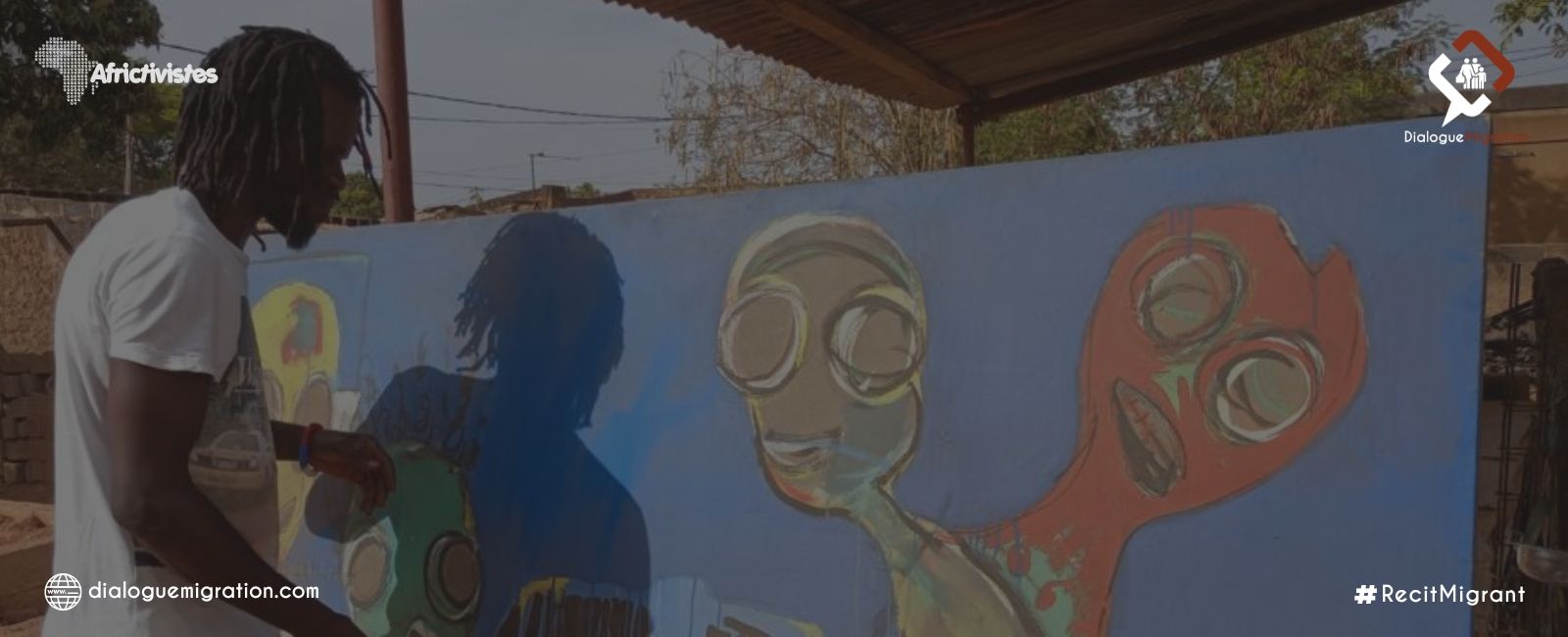

Patrick Kodjo Agbowadan arrived in 2009 from his native Togo. A visual artist, Patrick is a proven talent. Paintings with different figures are exhibited in the courtyard where he welcomed us. Some are hung on the wall and others leaning against tree trunks. It is in Goughin in the heart of Ouagadougou that Patrick builds his network. Patrick spoke toDialogue Migration while focusing on his art and social works for the benefit of disadvantaged children.
Patrick Kodjo Agbowadan said that he does not know when he started his business because “one is born an artist, one does not become an artist”. He adds that he was born into a family that has always practiced art.
From a sculptor father, Patrick chose plastic art to convey his “messages, what is inside me, my history and my life”. His works show characters that are sometimes deformed, in difficulty and are mostly children. In a painting entitled “l’ambiance des mômes”, we see children playing but are surprised by the atrocity that surrounds their environment.
On another painting with a yellow background is a child who seems frightened, opening his eyes and observing with anxiety. “L’Agenouement” is how Patrick calls his painting which, according to him, reflects the reality of his host country Burkina Faso at a given time. The artist, who was in creative residency when the coup d’état occurred on January 24, 2022, said that the coup explains the panic of the kid on the painting.
According to the artist, he uses children as characters because they are his “sources of inspiration”, in addition to being “divine”. They are also the “hope of tomorrow” who must be protected. To do this, he and his wife, also a painter and actress, created the association “Terre des mômes” which is largely financed through the sale of their works.
“Art is wealth. It’s my interior, it’s a part of me, it’s my personality, “ confesses the Togolese who believes that Burkina Faso is a fertile land for the practice of his profession.
Sitting on a chair, Patrick never ceases to contemplate his own works. Then suddenly, he gets up, takes a kettle which he fills with water and then equipped with a piece of cloth, he begins to wash some paintings covered with a fine dust. Once he had cleaned his works, he smiled faintly as if there was some kind of communion between him and his paintings. “My works fascinate me a lot,” he says.
Father of two children with his Burkinabe wife, Patrick says he has in the past tried other countries before heading to Burkina Faso about which he has heard some misconceptions. “Before coming to Burkina Faso, we were told that there was no hard-built house (with cement, modern materials). So ten years after having traveled to Benin, Nigeria, Liberia, here I am in Burkina Faso which has nothing to do with what we were told.” Obviously Patrick has found his niche in the country of the upright men during his 14 years of life. “I didn’t know Burkina Faso was going to be like this for me. It’s an inspiration to me,” he proudly says with a faint smile.
With a mother who is a traditional singer, Patrick practices voodoo as his religion and advocates for African youth to return to their roots. He says that his art contains virtues: “My art heals and cures. There are works that give fertility”, says the visual artist.
On migration, the man of culture suggests that every person is a migrant somewhere. He defines himself as a “universal” who travels everywhere to be able to express himself through his art. “When you don’t travel, you can’t create”, points out the artist who believes that man must have the freedom to go everywhere. «The person who travels sees better than the person who is upstairs”, states a proverb from my homeland.
Patrick dreams of a cultural mix between African peoples. He is convinced that it is the “cultural melting pot that will govern the world of tomorrow”. It is with this in mind that he is carrying out a project entitled “Let’s build together today, the hope of tomorrow” where artists from the Republic of Congo, Togo, Côte d’Ivoire, Nigeria, Benin and Burkina Faso will take part in a drive to create a kind of cultural African Union. Despite the difficulties, the artist recommends optimism to young Africans and asks them not to give up.


